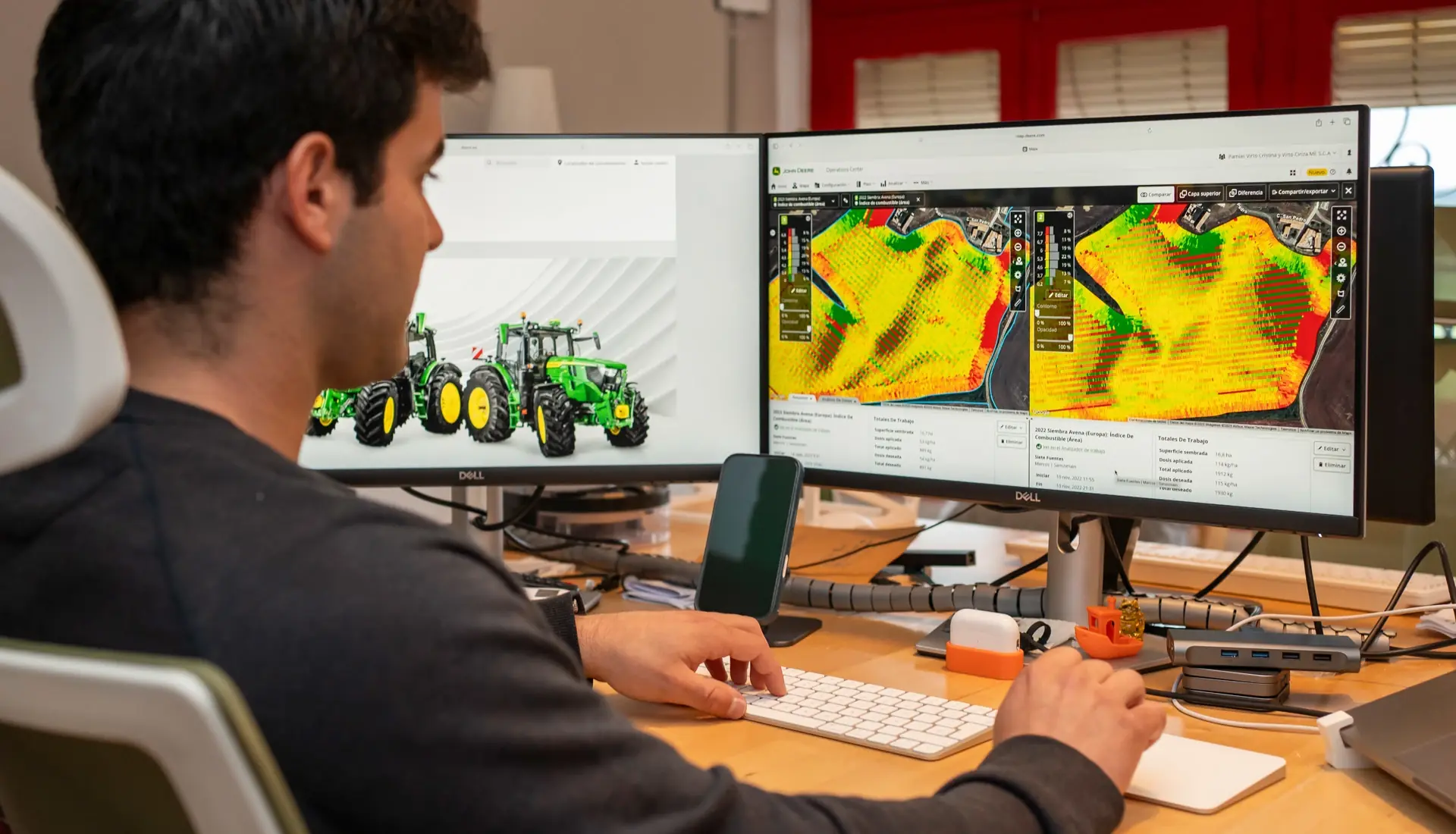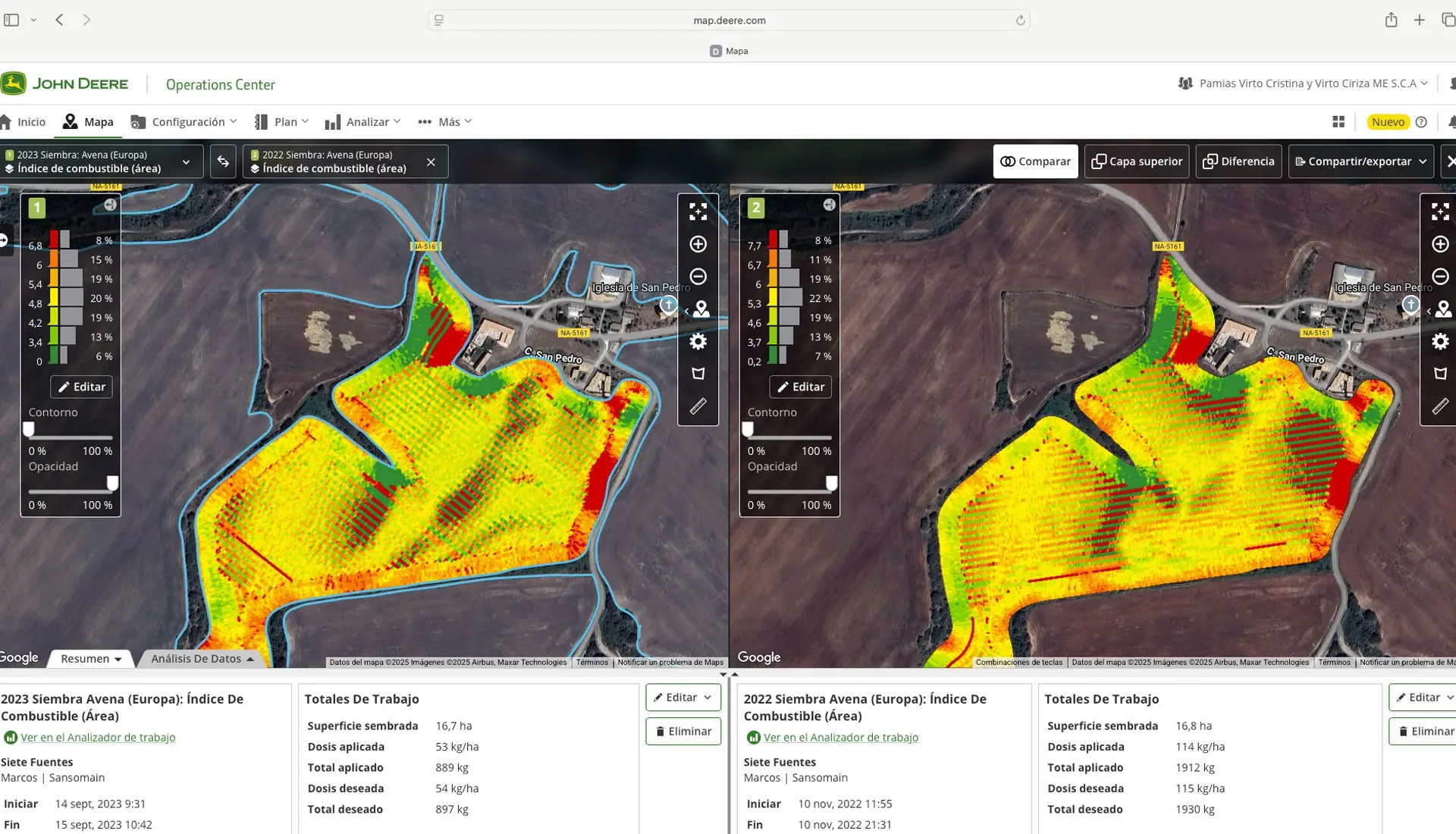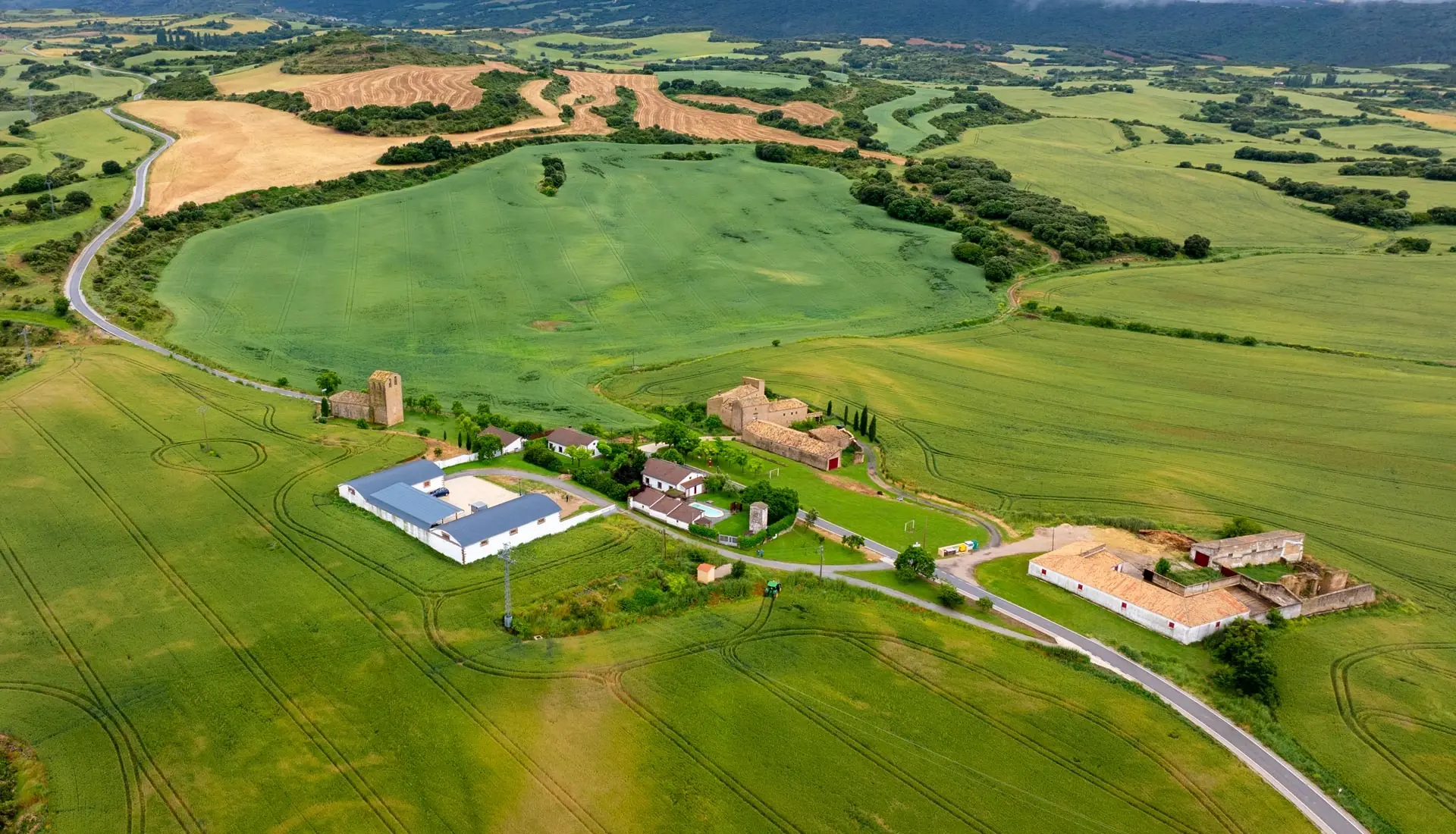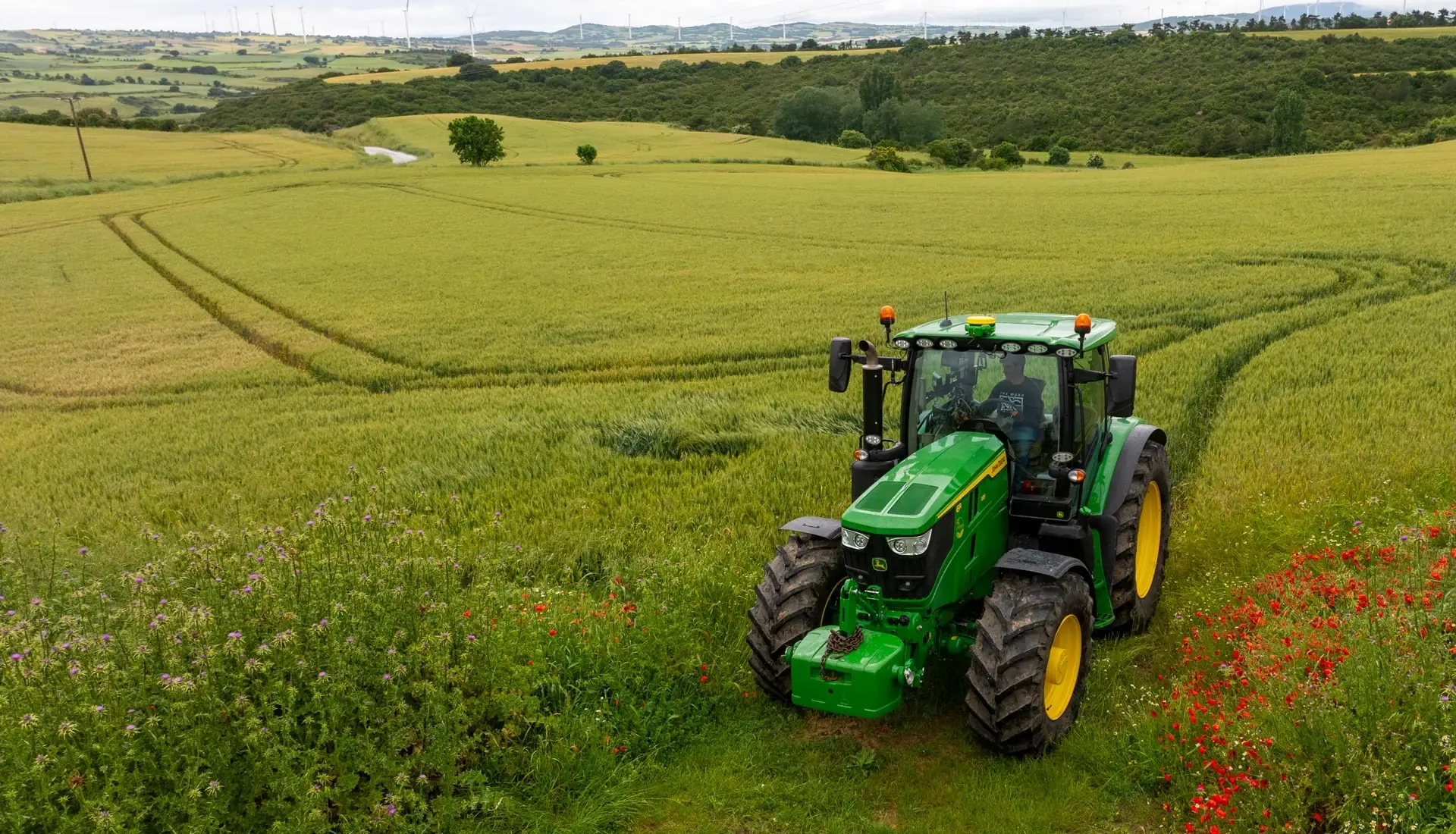Marcos Esteve is 28 years old and manages a family farm of 220ha in Navarre, where he mainly grows cereals like wheat, barley, and oats. He also includes leguminous crops like peas, rapeseed, and vetch in the crop rotation. His connection to the countryside began when his parents decided to move from Barcelona to Navarre, to live in a small village with seven inhabitants. In 2012, they started experimenting with organic farming, but when it proved unprofitable, they switched to conventional farming in 2016. “With the change, we aimed to achieve profitability without neglecting everything we had accomplished in terms of soil conservation through organic farming techniques,” Marcos comments.
The right machines
“At that time, we had a tractor which didn’t have auto-pilot, a display, or ISOBUS. I used to go out to work based on whether it had rained or not and using those kinds of visual estimates. After one season, back in 2017, I realised that our way of working could be greatly improved,” he explains. “For example, I realised that when using the spreader, I was either applying too much or not reaching the required dose, and that when working at a width of 24m, there were times when I only needed to spread over six metres, yet I was working at 12 because I would cut off one side, or 24 because I kept both sides. “So the following year, I introduced continuous weighing and section cut-off, and the savings were tremendous. Another year later, we switched to a John Deere tractor with GPS, an integrated display, ISOBUS, and we installed ISOBUS on the fertiliser spreader.”


The next step was to purchase a sprayer and acquire another tractor, a John Deere 6R 155, superior to the previous ones, which featured telemetry, advanced connectivity, and automatic headland turning, allowing Marcos to further improve the tasks he carries out. Marcos does not follow the general trend of buying tractors. He prefers to lease them. “It’s much more convenient to pay a monthly fee and change tractors every five years. This way, our tractor never becomes outdated, and the monthly payments include everything we need,” he says. “This gives us more peace of mind, as it relieves us of the worry about maintenance costs, including tyre changes, or any repairs that might arise.” He currently has a John Deere 6R 185 that is only a few months old.
Change in farming practices
With the previous approach, the family used chisel ploughing and harrowing, but four years ago they decided to switch to no-till seeding on all the fields, using cover crops and straw chopping. And it is yielding very good results. According to their calculations, just by not tilling, they save 300–400 hours of work per year. One of Marcos’ goals is to have a living soil that can unlock nutrients and retain moisture. “The soil is a fundamental element that should be cared for,” he says. Leaving the chopped straw on the field surface provides him with an additional 1.2 to 1.5t/ha of organic matter per year. “We mainly plant leguminous crops to care for the soil, although we harvest them at the end of their growing cycle. They provide us with 20-30kg/ha of nitrogen, which we save on fertiliser for the following year.”

Precision agriculture is not the future; it has been around for years.
Marcos Esteve
After harvesting, he aims to plant a cover crop to protect the soil, increase organic matter content, and promote moisture retention. “During drought periods, the difference is noticeable; we are less affected by the lack of water, and we protect our production.” He also acknowledges that with direct drilling, not everything is advantageous; there are certain drawbacks, like the emergence of pests the farm didn’t have before, like slugs, which have appeared due to the increased moisture.
Planning with data
Marcos studied mechanical engineering, but his passion is agriculture. He firmly believes that precision agriculture is not the future; it has been here for years. “Primarily, I rely on yield maps, with their weight and crop moisture content. Additionally, with the tractor, I document all the tasks I perform, the paths taken in each field, and the most important operating parameters (fuel usage, revolutions, engine load and temperature, and wheel slippage). I also use a self-developed app, along with data layers from different sources, to automate the generation of prescription maps that increase profitability and optimise resource use.”
He uploads all this data to the John Deere operations centre platform and verifies it from his mobile phone when he is in the field. Once the workday is over, he returns home, where he consults the platform again on his computer and makes decisions about how, when, and where to carry out the next tasks. He transforms these decisions into prescription maps that he sends to the tractor, and these prescriptions are automatically executed in the field. His machinery fleet is perfectly adapted to his needs. He has a tractor, a seed drill, a fertiliser spreader, a sprayer, and two trailers. The tractor is almost autonomous; when it is working, the paths, headland turns, and variable dosing of seed, fertiliser, or plant protection products are carried out according to the corresponding prescription loaded previously. He only needs to use the steering wheel to drive the tractor from the shed to the fields and back.
Tractor paths
Marcos has dedicated many hours to optimising the tractor paths when working in the field. “I optimise them based on the yield maps and the paths of previous tasks. I detect unnecessary passes, those where the working width is much less than the implement I am using, and I improve them for future occasions.” With this, he has managed to significantly reduce the time per field, diesel consumption, and tractor wear.
What does he achieve with all this?
All his crops are rain-fed, achieving average yields of 5.6t/ha for wheat, 5.1t/ha for barley, and 4.6t/ha for oats. In 2025, the rainfall has been very good, but the trend in recent years suggests that rainfall is decreasing. However, thanks to all the improvements he has been implementing, the farm has managed to increase yields, by 22% in the case of wheat, since 2015. At the same time he has reduced fertiliser use by 22%, plant protection products by 40%, and seed by 12%. “And we have increased the productivity of our work by 30%, cutting the time needed for each task.”
The soil is a fundamental element that needs to be cared for.
Marcos Esteve
As for diesel, consumption has decreased from 10,000 litres per year to just 3,600. “With the tractor, we now use 8.4 litres/ha of diesel to grow cereals,” notes Marcos. Although direct drills are more expensive than conventional ones, calculations show that the investment will be recouped within five to six years. His efforts don’t stop there; he is currently developing an artificial intelligence-based software platform that will further optimise his work in the field and, consequently, the farm’s profitability.




